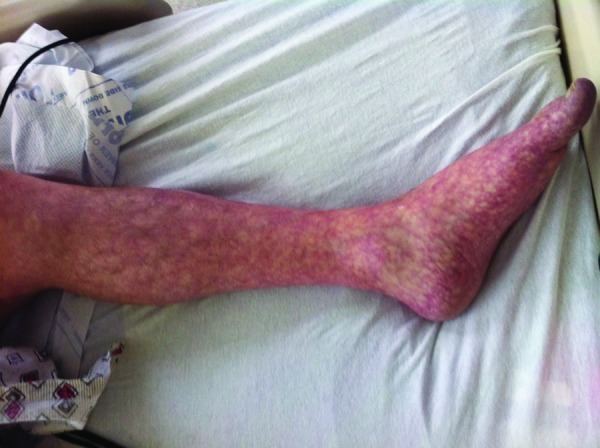Livedo reticularis is a common skin finding consisting of a mottled reticulated vascular pattern that appears as a lace-like purplish discoloration of the skin. The discoloration is caused by swelling of the venules owing to obstruction of capillaries by small blood clots. The blood clots in the small blood vessels can be a secondary effect of a condition that increases a person's risk of forming blood clots, including a wide array of pathological and nonpathological conditions . Examples include hyperlipidemia, microvascular hematological or anemia states, nutritional deficiencies, hyper- and autoimmune diseases, and drugs/toxins.
The condition may be normal or related to more severe underlying pathology. Its differential diagnosis is broadly divided into possible blood diseases, autoimmune (rheumatologic) diseases, cardiovascular diseases, cancers, and endocrine disorders. It can usually (in 80% of cases) be diagnosed by biopsy.
It may be aggravated by exposure to cold, and occurs most often in the lower extremities.
The condition's name derives from the Latin livere meaning bluish and reticular which refers to the net-like appearance.
A number of conditions may cause the appearance of livedo reticularis:
Cutis marmorata telangiectatica congenita, a rare congenital conditionSneddon syndrome – association of livedoid vasculitis and systemic vascular disorders, such as strokes, due to underlying genetic causeIdiopathic livedo reticularis – the most common form of livedo reticularis, completely benign condition of unknown cause affecting mostly young women during the winter: It is a lacy purple appearance of skin in extremities due to sluggish venous blood flow. It may be mild, but ulceration may occur later in the summer.Secondary livedo reticularis:Vasculitis autoimmune conditions:Livedoid vasculitis – with painful ulceration occurring in the lower legsPolyarteritis nodosaSystemic lupus erythematosusDermatomyositisRheumatoid arthritisLymphomaPancreatitisChronic pancreatitisTuberculosisDrug-related:Adderall (side effect)Amantadine (side effect)Bromocriptine (side effect)Beta IFN treatment, i.e. in multiple sclerosisLivedo reticularis associated with rasagilineMethylphenidate and dextroamphetamine-induced peripheral vasculopathyGefitinibObstruction of capillaries:Cryoglobulinaemia – proteins in the blood that clump together in cold conditionsAntiphospholipid syndrome due to small blood clotsHypercalcaemia (raised blood calcium levels which may be deposited in the capillaries)Haematological disorders of polycythaemia rubra vera or thrombocytosis (excessive red cells or platelets)Infections (syphilis, tuberculosis, Lyme disease)Associated with acute renal failure due to cholesterol emboli status after cardiac catheterizationArteriosclerosis (cholesterol emboli) and homocystinuria (due to Chromosome 21 autosomal recessive Cystathionine beta synthase deficiency)Intra-arterial injection (especially in drug addicts)Ehlers-Danlos syndrome – connective tissue disorder, often with many secondary conditions, may be present in all typesPheochromocytomaLivedoid vasculopathy and its association with factor V Leiden mutationFILS syndrome (polymerase ε1 mutation in a human syndrome with facial dysmorphism, immunodeficiency, livedo, and short stature)Primary hyperoxaluria, oxalosis (oxalate vasculopathy)Cytomegalovirus infection (very rare clinical form, presenting with persistent fever and livedo reticularis on the extremities and cutaneous necrotizing vasculitis of the toes)Generalized livedo reticularis induced by silicone implants for soft tissue augmentationAs a rare skin finding in children with Down syndromeIdiopathic livedo reticularis with polyclonal IgM hypergammopathyCO2 angiography (rare, reported case)A less common skin lesion of Churg-Strauss syndromeErythema nodosum-like cutaneous lesions of sarcoidosis showing livedoid changes in a patient with sarcoidosis and Sjögren's syndromeLivedo vasculopathy associated with IgM antiphosphatidylserine-prothrombin complex antibodyLivedo vasculopathy associated with plasminogen activator inhibitor-1 promoter homozygosity and prothrombin G20210A heterozygosityAs a first sign of metastatic breast carcinoma (very rare)Livedo reticularis associated with renal cell carcinoma (rare)Buerger's disease (as an initial symptom)As a rare manifestation of Graves hyperthyroidismAssociated with pernicious anaemiaMoyamoya disease (a rare, chronic cerebrovascular occlusive disease of unknown etiology, characterized by progressive stenosis of the arteries of the circle of Willis leading to an abnormal capillary network and resultant ischemic strokes or cerebral hemorrhages)Associated with the use of a midline catheterFamilial primary cryofibrinogenemia.Other than identifying and treating any underlying conditions in secondary livedo, idiopathic livedo reticularis may improve with warming the area.

